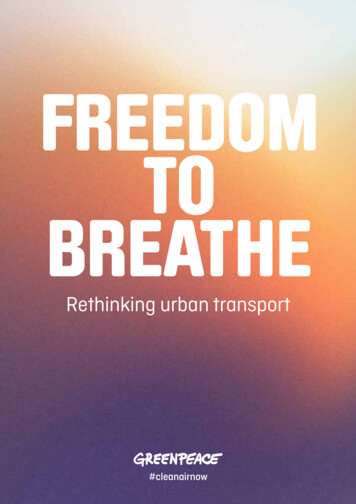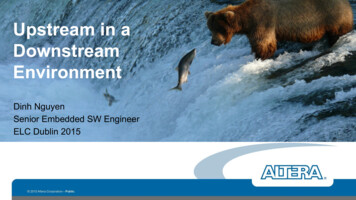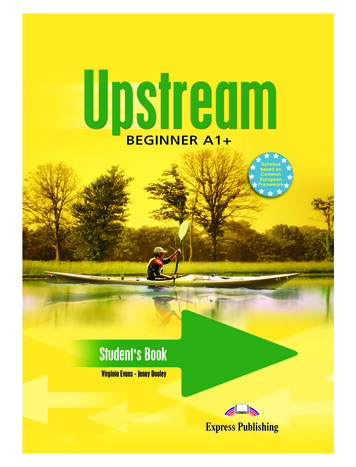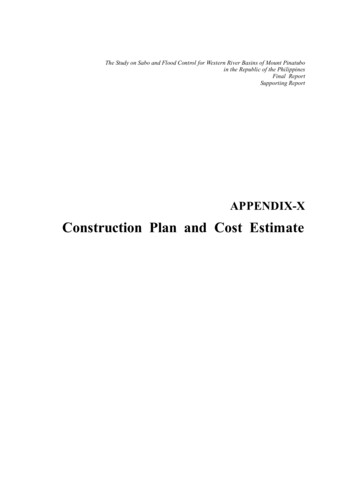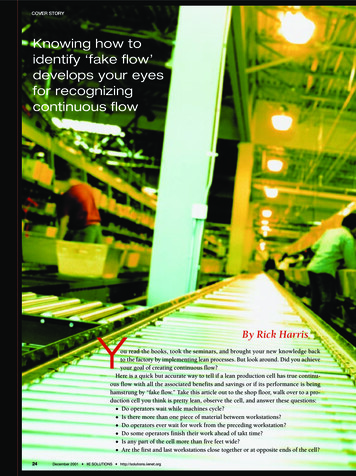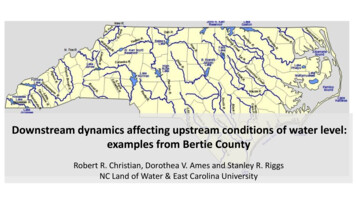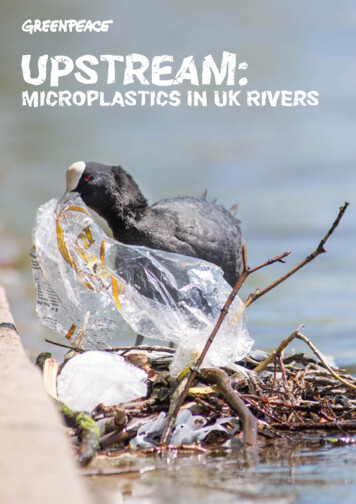
Transcription
UPSTREAM:MICROPLASTICS IN UK RIVERS
WHAT WE FOUND1. A widespread Greenpeace survey of 13 UK rivershas found that they all contain plastic pollution.In the first nationwide exercise of its kind, ourscientists found microplastics (items measuringless than 5mm) in 28 out of 30 locations tested.2. A total of 1,271 pieces of plastic – ranging insize from straw and bottle-top fragments totiny microbeads less than 1mm across – werecaptured in a specially designed net.3. The highest concentration of plastics found wasin the River Mersey. In just half an hour, 875 pieceswere captured. This made the Mersey, at the timesampled, proportionately more polluted than theinfamous Great Pacific Garbage Patch.4. Microbeads – tiny plastic spheres often used incosmetics and household products – were foundin five of the 13 rivers. Samples from the Merseycontained 36 plastic microbeads despite themhaving been partially banned in 2017.5. Samples from seven locations contained plasticpellets called ‘nurdles’, which are used as a rawmaterial in the production of plastic products.Again, the most contaminated sample was fromthe Mersey, where 79 nurdles were captured closeto a plant that mass-produces the pellets.6. More than 80% of the polymer types we foundwere polyethylene, polystyrene and polypropylene.These are used to make a wide variety of plasticproducts such as food packaging, milk and waterbottles as well as carrier bags.We sampled rivers across England, Wales,Scotland and Northern Ireland – the Exe, Thames,Severn, Great Ouse, Trent, Mersey, Aire, Derwent,Wear, Conwy, Wye, Clyde and Lagan.Wildlife and plastic waste, including single-use plastic, found on the River Lea, 15 Feb 2019. Povey/Greenpeace
THe riverswe testedKEY:Plastics factories12Plastic pieces at sample location12Total number of plastic piecesfound in river samples overallBritish IslesGlasgow 6Edinburgh5River Clyde11Newcastle1BelfastRiver Lagan122River Derwent10239River Wear10River AireBradfordRiver nthorpeRiver Trent14350River ConwyDerby92121King’s LynnRiver Severn0420Birmingham15River Wye1067CardiffBristol121River GREAT Ouse1Milton KeynesOxford13London8 66River Thames108124 77ExeterRiver Exe233
MICROPLASTICSIN RIVERSCommon kingfisher perched on discarded litter near Deptford Creek, London, 27 Sept 2013.International concern over plastic polluting the oceans has grownexponentially over the past two years. Reports of huge oceangarbage patches and images of seabirds feeding plastic to theirchicks, or dead whales washing up on beaches – their stomachsfull of plastic bags – are ubiquitous in the world’s media.Less attention, however, has been paid to levels and toxicity ofplastic in UK rivers, even though an estimated 80% of plasticpollution found in oceans begins its journey in inland waterways– from urban landfill and sewage sludge run-off, industrialactivity, waste treatment plants and littering. The remaining 20%originates from sea-based activity such as fishing and dumpingfrom ships (Li et al., 2018).4Rivers flow surely to the sea, and scientists believe as many as60 billion pieces of plastic are discharged into oceans from riversworldwide each day (GESAMP, 2016). In spite of this, academicstudies into microplastics in freshwater systems have receivedfar less attention than plastics in oceans and they remainwoefully understudied to date.Research into the levels and effects of plastic in rivers has begunto accelerate in recent years, but there are still many fundamentalgaps in scientific understanding of the distribution, complexityand impacts of plastics as contaminants in freshwaterecosystems. Given that the cause of most ocean pollution isto be found upstream, understanding the ways in which rivers
Perks/Greenpeace Perks/GreenpeaceIn the UK, limited studies in recent years have found evidence ofmacro and microplastics in rivers including the Thames, Mersey,Trent, Tamar, Usk, Taff and Wye (Horton et al. 2017; Tibbets et al.2018; Hurley et al. 2018; Morrit et al. 2014; Kay et al. 2018;Sadri & Thompson 2014; Gallagher et al. 2015). Perks/Greenpeace Brangwyn/Greenpeacecontribute to the transfer and concentration of plastics, includingmicroplastics, is of crucial importance. Furthermore, it is vitalto recognise that waterways are not simply conduits that carrywater, sediments and associated pollutants to the coast, but thatthey are also complex and fragile ecosystems in their own rightand they need our protection.In order to expand upon this work, during February and March2019 Greenpeace UK conducted what we believe to be the mostgeographically widespread survey to date of plastic pollution inthe surface waters of British rivers, by using a specially designedfloating ‘manta’ net to collect samples from 30 locations along 13different rivers – nine in England, two in Wales, one in Scotlandand one in Northern Ireland.Our findings provide an original, unique and worrying insight intothe diversity and spread of plastic pollution in the UK’s waterways.Top: A brown trout swims next to a plastic bottle in the River Derwent in Derbyshire, a tributary of the River Trent, 25 Feb, 2019.Middle: An otter is photographed next to a plastic bottle at the Little Ouse river in Norfolk, 31 October 2018.Bottom: A coot sits on a nest built with plastic in the River Lea, 13 May 2019.5
HOW WE DID ITThe rivers we testedWe sampled the Exe, Thames, Severn, Great Ouse, Trent, Mersey,Aire, Derwent, Wear, Conwy, Wye, Clyde and Lagan.How we did itResearchers, volunteers and scientists collected samples forlaboratory analysis from river surface water at 30 locationsacross 13 river systems between 6 February and 29 March 2019.Rivers were selected to include both rural and urban locations,and samples were collected far enough upriver to ensure noplastic debris had come from the sea during high tides.We collected the samples using a manta net, a specialised pieceof equipment resembling a manta ray, with two buoyant ‘wings’and a large rectangular ‘mouth’ connecting to a net where thedebris collects. Its mouth measures 30cm x 15cm and the sizeof the mesh was the same as that used in numerous studieselsewhere in the world: 0.33mm.The manta net was secured either to the riverbed by anchoror to an overhead footbridge for periods of time which varieddepending on the rate of flow of the river and to avoid the netbecoming overfilled and clogged. At the end of each samplingperiod, the net was retrieved and the contents taken to theGreenpeace Research Laboratories at the University of Exeter.Here, the collected plastic items were divided into four sizes:macroplastics measuring more than 5mm in at least onedimension, microplastics of between 5mm and 2mm andbetween 2mm and 0.3mm in size, and microfibres less than 1mmin diameter, though of varying lengths. They were then subjectedto rigorous analysis.Top L-R: The manta net in operation on the RiverSevern, 4 Mar 2019. Rose/Greenpeace.Greenpeace team samples the waters of the RiverClyde, 27 Mar 2019. Sutton-Hibbert/Greenpeace.The field team preparing to test from a footbridge onthe River Mersey, 19 Mar 2019. Morgan/Greenpeace.Middle L-R: Sample from the River Clyde in a glassjar, 27 Mar 2019. Sutton-Hibbert/Greenpeace.Fiona Nicholls, Greenpeace campaigner (right) andwildlife biologist Kirsten Thompson (left) inspecta sample taken from the River Clyde, 27 Mar 2019. Sutton-Hibbert/Greenpeace.6Bottom: Hollywood actor Bonnie Wright joinsscientists and campaigners to investigate plasticpollution in the River Wye, 5 Mar 2019. Rose/Greenpeace.
FINDINGSOverallAt least one piece was found at 28 of the 30 locations sampled.In total, 1,271 pieces of plastic were captured, ranging in size fromplastic straw and bottle-top fragments to microbeads measuringless than 1mm across.The study’s findings reflect plastic contamination of rivers basedon a snapshot in time. The most contaminated river in the studywas the Mersey, with a total of 942 pieces across both samples.Using the same measure other studies have used (describedbelow), if we were to extrapolate our findings for the Mersey, wewould find it contains more than 2 million pieces of microplasticper square kilometre, a number higher than that found at theinfamous Great Pacific Garbage Patch that accumulates withinthe North Pacific Gyre (Moore et al. 2001, found a maximum of334,271 pieces per square kilometre; Law et al. 2014, found morethan 1 million pieces per square kilometre).During the time we took samples, two out of 30 revealed noplastic; these locations were relatively rural sites on the Conwyand Great Ouse.5mmDiameter or length thatis greater than 5mmMICROPLASTICS5 mmvMany of the other rivers in the study also revealed high levels ofplastic contamination. The Thames samples contained a totalof 108 pieces of plastic, the Aire revealed 63 in total, the Severncontained 42 pieces and the Trent samples had 35 pieces. TheExe samples contained 23 pieces of microplastic in total, theLagan had 12, the Clyde 11, the Derwent and Wye both had 10,the Wear had five and the Great Ouse contained one.MACROPLASTICSvWe found plastic in every river we tested across the UK.Diameter or length that is up to and including 5mmCan be divided into:PrimarymicroplasticsPlastic particles thatwere manufacturedto be a particular size,eg microbeads, nurdlesSecondarymicroplasticsPieces of plastic thathave been degraded froma large item, eg plasticbottle to a smaller sizeSizes, types and kinds of plasticpollution foundMore than 80% of all the plastic items recovered fell into threepolymer types – Polyethylene (PE), polystyrene (PS) andpolypropylene (PP). These are the types most widely used for‘disposable’ single-use packaging. Smaller amounts of a further12 polymer types were also identified, including ethylene-vinylacetate (EVA), polyvinyl chloride (PVC), polyethylene terephthalate(PET) and polyamide (PA).NANOPLASTICS1 umvPlastic fragments and microbeads less than 2mm in size werethe most commonly found (517 pieces), closely followed byfragments and pellets between 2mm and 5mm in size (505pieces). In total, 170 fragments or pellets of plastic with at leastone dimension greater than 5mm were recovered. We also found80 plastic fibres of varying widths and lengths.Considered a subset of microplasticsDiameter or length that is smaller than 1umThere is currently no formal size definition for microplastics.For the purposes of this report we have adopted the measurements in theGESAMP (2015) report, which states that microplastics are considered tobe in the size range 1um to 5mm.7
Another conspicuous type of plastic pellets, more cylindrical inshape and about 5mm in length, were identified as ‘biobeads’, orplastic pellets that are used in water treatment works to providesurfaces for micro-organism growth. These were found insamples from four of the locations – the two from the Mersey(containing 59 and two biobeads respectively), one sample fromthe Severn (two biobeads) and one sample from the Aire (12biobeads). Hyde/GreenpeacePlastic sample from the River Mersey, showing a microplastic particlebeing separated from organic material at Greenpeace ResearchLaboratories, 17 Apr 2019.Of the three main polymers found, polyethylene was the mostcommon, amounting to 46% of all plastic items. It was found inirregular coloured fragments, sections of transparent or colouredfilm (such as that used in food packaging), microbeads of thetype formerly permitted for use in toothpastes, shower gels andother personal care products, ‘nurdles’ (plastic pre-productionpellets) and ‘biobead’ pellets, which are used to provide surfacesfor bacterial and fungal growth at wastewater treatment plants.Polyethylene is used in a wide variety of products, includingmilk bottles, household cleaning products and a huge range ofcontainers for consumer and industrial use.Two samples each from the Mersey and the Aire containedexpanded polystyrene beads (which are commonly used inpackaging, notoriously brittle and difficult to recycle). In the mostcontaminated Mersey sample, 127 were captured while 18 werefound in the second Mersey sample. The Aire samples containedone and five polystyrene beads respectively.Among the macroplastic items found in the manta nets (ie morethan 5mm in at least one dimension) were clear and colouredpieces of film or foil (in the Thames, Severn, Mersey andDerwent); PVC cable sheathing (Thames); part of a bottle cap,packing strap, strimmer line, plastic straw andring (Mersey); and clothing tag debris (Wye).8Given their use in water treatment plants, and the evidencethat some are made from relatively low grades of recycledplastic (Turner et al. 2019), biobeads may be expected to carryparticularly high burdens of chemical (as well as biological)contaminants.Comparative studiesThis study presents a ‘snapshot’ of pollution levels on the daysand in the stretches of river we sampled. Given a variety ofweather conditions, differing days or times of sampling, or theduration of testing, the results in each river could have been verydifferent. Longer-term sampling would be necessary to establishmore fully the extent to which each waterway is polluted byplastics.Nonetheless, taking the sample set from this study, it is possibleto compare the overall results with those reported by otherstudies. In the few studies to date that have quantified plasticcontamination of surface river water, most express their data interms of number of total plastics and microplastics per cubicmetre of water.Nurdles, biobeads, polystyrene balls and other microplasticsfrom the River Mersey. Hyde/Greenpeace.
1,271pieces found in total517pieces less than2mm in size505pieces between2mm and 5mm in sizeAll other types of plastic found, including:Ethylene-vinyl acetate (EVA)Polyvinyl chloride (PVC)Polyethylene terephthalate (PET)Polyamide (PA)Polypropylene (PP) – wefound this largely in the form ofnurdles and fibres, as well asvariously coloured fragmentswhich may have broken awayfrom items like bottle tops orfood containersPolystyrene (PS) – we found thislargely in the form of polystyrenebeads as well as some white andcoloured fragments of microplastic170pieces over5mm in sizepese nt t ydiffer icstof pla1415%17%46%Polyethylene (PE) – we foundthis in irregular colouredfragments, sections of film,microbeads, nurdles andbiobeads23%On that basis – and assuming our net was routinely sampling toa depth of 10cm – the estimated average number of pieces ofplastic across our 27 samples was 1.293 pieces per square metre(median 0.129 pieces per square metre, maximum at one of thetwo sites on the Mersey at 27.35 pieces per square metre).Using similar net systems, Sadri & Thompson (2014) recordedan average of 0.028 plastic pieces per square metre in the RiverTamar in the south-west of England, lower than the median valuein our study.However, another UK study found levels slightly higher than ourmedian value. This examined levels of plastics in the surfaceestuarine waters of three rivers flowing into the Solent inSouthampton and expressed the data in terms of number ofplastic pieces per square metre, ie surface area sampled ratherthan total volume swept (Gallagher et al. 2015). On this basis, theaverage values for those estuaries (between 0.4 and 5.86 piecesper square metre) are slightly higher than the average valuesdetermined from our findings (0.129 total pieces of plastic persquare metre, 0.108 microplastics per square metre).
WILDLIFE IMPACTSScientists believe that as many as 1 million species are facingextinction (IPBES 2019) due to the pressures on nature fromclimate change and rising levels of pollution. The impact of largepieces of plastic litter on marine life – through entanglement,choking and strangulation – has been well documented.Less well known is the extensive research that demonstrateshow microplastics can be ingested by marine life and causeproblems because of their presence in the gut and the chemicalcontaminants they carry.A water vole and single-use coffee cup lid at the River Derwent,Derbyshire, 30 Apr 2019.When mistaken for food and eaten by marine species,microplastics have been shown to cause gut blockage andphysical injury, alter feeding behaviour and affect energy levels,growth rates and reproduction (Greenpeace 2016). For instance,microplastic ingestion has been found to decrease energyreserves and reduce feeding activity in marine worms, a keystonespecies inhabiting intertidal sediments in Northern Europe(Wright et al. 2013). Hyde/GreenpeaceWe also know that microplastics can take on and leach outchemicals, and that as a result these chemicals can end upin the tissues of marine species. For instance, fish exposedto polyethylene microplastics with pollutants sorbed from themarine environment accumulated the pollutants and sufferedliver toxicity (Rochman et al. 2013).A mute swan is photographed underwater next to a plastic bag in the River Trent, 25 Feb 2019.During our campaign we witnessedvoles eating plastic and swans using itto build their nests. Perks/Greenpeace
eces ofses from small pibuild protective caaervrecentlylaenlybeisfsddhathe moth, caves and – asofnleaioglatyinrecaticde,uandAn aqgs of: twigs, saed into the casinerbed around thembeing incorporatticaspldebris from the rivfair toofisctitpawlimriver waterfooplastic. The fullthe diet of manyofrtobserved – micrus wildlife.paioasechprrugfood web of outermined, althoedethrunteisenslietosisfticcaddroute for plasis is yet anotherspeculate that th Perks/GreenpeacecitsalpThis isA caddisfly larva with plastic incorpoated into its protective case in the River Tame, Birmingham, 2 May 2019.Very limited research has been done into the impact of macroplastics on river wildlife – though during our campaign wewitnessed voles eating plastic and swans using it to buildtheir nests. Even less data exists on the levels and impacts ofmicroplastic ingestion by river species such as fish, otters andswans. However, we can anticipate that microplastics could havea similar impact on river species to ocean species. Perks/GreenpeaceAmong the clearest evidence to date that freshwater species areexposed directly to microplastic pollutants is provided by the workof Windsor et al. (2019), who recently documented the presenceof microplastics in the guts or other tissues of several species ofinvertebrates (including insect larvae) collected at locations alongthe rivers Usk, Taff and Wye in South Wales.A common frog sitting among plastic in the Grantham Canal, 10 May, 2019These findings raise the possibility that those ingestedmicroplastics may subsequently be transferred up through thefood web to predators such as fish and birds, though this remainsto be confirmed. At the same time, recent laboratory studies onmosquito larvae have suggested that there are mechanisms bywhich microplastics taken up by aquatic larval stages of insectsmay even be carried over through pupation into adult insecttissues and thereby distributed from one river system to another(Al-Jaibachi et al. 2018). Perks/GreenpeaceFurther studies of exposure to, and physiological effects of,microplastics within aquatic species are needed as a matterof some urgency. Meanwhile, it is important to recognise thatplastics of all forms entering rivers today are likely to persistfor some considerable time in the environment and may beirretrievable.A coot and its chick are pictured with plastic in the River Lea,12 May 2019.11
CASE STUDY – Nurdles in the MerseyNearly all plastic we encounter from day to day begin lifeas a nurdle, a small, lentil-sized plastic pellet that can bemelted, coloured and moulded into any shape a manufacturerdesires. Billions are used by the plastics industry every year,but mishandling and mishaps in transit mean that increasingnumbers of nurdles are ending up at sea and in our rivers.According to the British Plastics Federation, there are 5,200plastics manufacturers in the UK producing 1.7 million tonnesof raw plastic each year. Nurdle manufacturers such as BasellPolyolefins cannot keep pace with demand, and so a shortfall of2.3 million tonnes is imported by sea each year from around theworld, increasingly from the Middle East and Asia.Each tonne of plastic is made of 50 million nurdles (Cole et al.2016), and bulk trucks carry around 2 billion nurdles per load(United States EPA 1992). Nurdles pose a significant threat tothe environment when mismanaged. Once spilt, they can be lostdown drains around the factory building and carried out to sea(United States EPA 1992).Nurdles, in common with all microplastics, can attract persistentorganic pollutants (POPs), toxic synthetic chemicals such aspesticides or industrial products that can accumulate in tissueand resist degradation. These chemicals can accumulate on thesurface of nurdles, and as the pellets fragment into microplasticparticles they can be mistaken for food by marine animals andseabirds and so enter the food web.One of the UK’s largest plastic nurdle production facilities, BasellPolyolefins UK, sits beside the River Mersey. As with the otherrivers, we sampled the Mersey at two separate locations; onerural and another downstream of an urban conurbation. In thecase of the Mersey these two testing sites also sat either sideof Basell Polyolefins, which produces and distributes the plasticpellets. What we found was highly disturbing.Upstream of Basell Polyolefins, we found 67 microplastic pieces(including just two nurdles). In terms of levels of plastic pollution,taking account of the different river flow rates, this figure canbe considered very high and is significantly higher than theaverage found in most other comparable sites tested. However,what we captured downstream of Basell Polyolefins was simplystaggering – 875 pieces of microplastic, including 79 nurdles, injust half an hour of sampling.The river was more than 10 times more polluted downstream ofthe nurdles factory than upstream of it.Samples from seven locations in the study contained nurdles inthe size range 3-5mm in diameter. Again, the most contaminatedsample was that from the Mersey (the 79 nurdles). Two othersamples, one from the Mersey and one from the Thames,contained two nurdles and one was found in asample from the Aire.NurdlesBasell Polyolefinsplastic production facility(manufactures nurdles)ManchesterLiverpool79RiverMe r eys2Sheffield2 nurdles found79 nurdles foundCASE STUDY: Microbeads – two yearson from the ban, what is going wrong?‘Microbeads’ are microplastic ingredients that are added toproducts such as cosmetics and toiletries, including face scrubs,toothpastes and shaving products, as well as household cleaningproducts such as floor cleaners and paints.The impact of microplastics on the environment has been welldocumented and led to the UK Government banning the saleof products containing microbeads in January 2018. However,the ban was limited to rinse-off products and excluded somecommonly used cosmetic products such as sunscreen, lipstickand household products.The findings of this report provide clear evidence that, more thana year on from the ban, microbeads continue to enter the UK’swaterways, whether as a legacy of previous use, continued use ofolder products or from use in products that were not covered bythe ban.Samples collected from five locations contained microbeadsin the size range 0.5mm-2mm and in various colours(predominantly pink, green or blue). The most contaminatedsample from the Mersey contained 36 microbeads. The twosamples from the River Trent contained 10 and seven microbeadsrespectively. One sample from the Great Ouse and the Aire eachcontained one microbead.Thi sinvestigation suggests that the current ban is failing toadequately address microbead pollution and needs to beextended to cover all products that contain microbeads.Nurdles and other microplastics from the River Mersey. Hyde/Greenpeace.Close-up image of microbeads. Image courtesy of The 5 Gyres Insitute.For more info about the work of the institute, go to 5gyres.orgMicrobeads
CONCLUSIONS1. The results of this geographically widespread ‘snapshot’survey demonstrate that plastic pollution is common to all therivers investigated at some level, at almost all the locationssampled, and at some locations is already severe. Onceplastics, especially microplastics, have reached a river, itbecomes increasingly difficult, if not impossible, to removethem; they have become part of the hidden landscape of theUK’s waterways, with the potential to endanger wildlife and ourown health.2. While the use of the floating manta net provided us with away to collect samples in a consistent and controlled manneracross all the rivers we tested, by focusing on the surface10cm of the rivers, we are undoubtedly seeing only a smallproportion of the overall loading of plastics in our samples.In other words, we are witnessing just the tip of a plasticsiceberg.3. We have also investigated only those plastics down to asize range of around one-third of a millimetre, in commonwith many previous studies of microplastics both in marineand freshwater. This means we were unable to to captureefficiently the smallest sizes of microplastics or microfibres,like those known to shed from clothing.This is significant, as studies that have employed nets witha finer mesh, or even the filtration of whole water samplesthrough meshes or filters of much smaller pore size, oftenreport higher concentrations of microplastics than arerecorded with manta net surveys.4. Although we found high numbers of ‘nurdles’, ‘biobeads’,expanded polystyrene spheres and even microbeads in someof the samples, the majority of microplastics we found werefragments formed from the break-up of larger plastic items,perhaps household products or single-use packaging. Inmost cases it will remain impossible to trace the fragmentback to a specific product or source.5. As was the case for the samples of microplastics collectedby Greenpeace UK from surface seawater around the coastof Scotland in 2017 (Santillo et al. 2018), all samples in ourstudy contained different types, sizes, forms and amountsof plastic. While this may be typical, even inevitable, for acontaminant of such discrete nature as microplastic, given thevast diversity of uses of plastic and routes to the environment,it highlights the challenge facing scientists who attemptto quantify risks posed by microplastics within the aquaticenvironment.By allowing the discharge and loss of plastics into ourfreshwater ecosystems, we have created a problem ofenormous complexity and unpredictability, and one to whichwe are adding every hour of every day until we stop the flow ofplastic at source.6. In this study, we have not been able to investigate the possibleimplications of exposure to the plastic pollution we havemeasured for the UK’s aquatic wildlife or human health.Nevertheless, given what is known already about the effectsof both macro and microplastics on marine wildlife, and theobservations from other studies that microplastics can beconsumed by a range of freshwater species, it is reasonable toassume that plastic pollution of our rivers poses some levelof threat to freshwater ecosystems.There is an urgent need for greater research to focus onexposures, food web transfer and mechanisms of biologicaleffect arising from plastic pollution of our waterways, as wellas for effective measures to identify, control and, as far aspossible, eliminate sources upstream.7. We know from other studies, again mainly in the marineenvironment, that plastics can contain additives andchemicals that become attached to their surfaces. Amongthese are: bisphenol A (BPA), a known endocrine-disruptingcompound; polychlorinated biphenyls (PCBs), which areknown to cause cancer and affect the reproductive systemsof animals; and dichlorodiphenyltrichloroethane, the pesticideDDT, which is another known carcinogen. (Browne et al. 2013;Rochman et al. 2013; Gauquie et al. 2015; Rani et al. 2017).In our earlier work on microplastics collected from the seasurface around the coast of Scotland, we reported that themixtures of chemicals associated with accumulations ofmicroplastics showed the same levels of complexity andunpredictability as microplastics themselves (Santillo et al.2018). There is no reason to expect this to be any differentin freshwater ecosystems, particularly given the moredirect exposure rivers face from discharges and run-off(i.e. pesticides, industrial chemicals, antibiotics).13
WHAT NEEDSTO BE DONE?The results of this study add to the overwhelming body ofevidence that there is a plastic pollution crisis affectingour human, freshwater and marine environments. If theGovernment is to show leadership in meeting this challenge, theremust first be an understanding and acknowledgment that relyingon recycling or switching to other materials is inadequate at bestand harmful at worst. Plastic production is set to quadruple by2050 (World Economic Forum, 2016), and as a material can onlybe functionally recycled a limited number of times. Therefore,we need a strategy to phase out all non-essential, single-useplastic packaging and a transition to a society in which refillable,reusable containers and materials are the norm.The upcoming Environment Bill, the first such bill in the UK formore than 20 years, offers a clear opportunity to enact policymeasures to radically reduce single-use plastic and put us oncourse to end all plastic pollution for good.The Government should set legally binding targets to reducethe production and use of single-use plastic packaging byat least 50% by 2025.These would lead to a shift towards packaging-free, reusableand refillable products that would drive down demand forand production of single-use plastics. These targets must beoverseen by a well-funded, independent watchdog with the powerto hold the UK Government and public bodies to account.The Government should commit that by 2042 at the latest,no
2. A total of 1,271 pieces of plastic – ranging in size from straw and bottle-top fragments to tiny microbeads less than 1mm across – were captured in a specially designed net. 3. The highest concentration of plastics found was in the River Mersey. In just half an hour, 875 pieces
